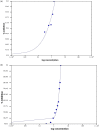In vitro and in silico β-lactamase inhibitory properties and phytochemical profile of Ocimum basilicum cultivated in central delta of Egypt
- PMID: 36226757
- PMCID: PMC9578474
- DOI: 10.1080/13880209.2022.2127791
In vitro and in silico β-lactamase inhibitory properties and phytochemical profile of Ocimum basilicum cultivated in central delta of Egypt
Abstract
Context: Some studies reported the chemical content and antimicrobial properties of Ocimum basilicum L. (Lamiaceae), relevant to the ecological variations in some areas of Egypt and other countries, yet no research was conducted on the plant cultivated in the central delta region of Egypt. Also, no previous data reported on inhibition of β-lactamases by O. basilicum.
Objective: To assess β-lactamases inhibition by O. basilicum extracts and the individual constituents.
Materials and methods: Dried aerial parts of O. basilicum were extracted by hydrodistillation for preparation of essential oil and by methanol for non-volatile constituents. Essential oil content and the methanol extract were analysed by GC-MS and UPLC-PDA-MS/MS, respectively. Methyl cinnamate was isolated and analysed by NMR. Broth microdilution method was used to investigate the antimicrobial against resistant clinical isolates of Escherichia coli identified by double disc synergy, combination disc tests and PCR. The most active oil content was further tested with a nitrocefin kit for β-lactamase inhibition and investigated by docking.
Results: O. basilicum was found to contain methyl cinnamate as the major content of the essential oil. More interestingly, methyl cinnamate inhibited ESBL β-lactamases of the type CTX-M. The in vitro IC50 using nitrocefin kit was 11.6 µg/mL vs. 8.1 µg/mL for clavulanic acid as a standard β-lactamase inhibitor.
Discussion and conclusions: This is the first study to report the inhibitory activity of O. basilicum oil and methyl cinnamate against β-lactamase-producing bacteria. The results indicate that methyl cinnamate could be a potential alternative for β-lactamase inhibition.
Keywords: Methyl cinnamate; antimicrobial.
Conflict of interest statement
All authors state that there is no conflict of interest to disclose.
Figures





Similar articles
-
Inhibitory effects of various essential oils and individual components against extended-spectrum beta-lactamase (ESBL) produced by Klebsiella pneumoniae and their chemical compositions.J Food Sci. 2011 Oct;76(8):M538-46. doi: 10.1111/j.1750-3841.2011.02363.x. J Food Sci. 2011. PMID: 22417594
-
Antibacterial properties of essential oils and methanol extracts of sweet basil Ocimum basilicum occurring in Bangladesh.Pharm Biol. 2010 May;48(5):504-11. doi: 10.3109/13880200903190977. Pharm Biol. 2010. PMID: 20645791
-
Chemical composition and bioactivity of essential oils and Ethanolic extracts of Ocimum basilicum L. and Thymus algeriensis Boiss. & Reut. from the Algerian Saharan Atlas.BMC Complement Altern Med. 2019 Jun 21;19(1):146. doi: 10.1186/s12906-019-2556-y. BMC Complement Altern Med. 2019. PMID: 31227024 Free PMC article.
-
Bio-active compounds and major biomedical properties of basil (Ocimum basilicum, lamiaceae).Nat Prod Res. 2025 Mar;39(5):1326-1344. doi: 10.1080/14786419.2024.2357662. Epub 2024 May 30. Nat Prod Res. 2025. PMID: 38813679 Review.
-
Antimicrobial and Other Pharmacological Properties of Ocimum basilicum, Lamiaceae.Molecules. 2024 Jan 12;29(2):388. doi: 10.3390/molecules29020388. Molecules. 2024. PMID: 38257301 Free PMC article. Review.
Cited by
-
Role of β-Lactamase Inhibitors as Potentiators in Antimicrobial Chemotherapy Targeting Gram-Negative Bacteria.Antibiotics (Basel). 2024 Mar 15;13(3):260. doi: 10.3390/antibiotics13030260. Antibiotics (Basel). 2024. PMID: 38534695 Free PMC article. Review.
-
Spermacoce alata Aubl. Essential Oil: Chemical Composition, In Vitro Antioxidant Activity, and Inhibitory Effects of Acetylcholinesterase, α-Glucosidase and β-Lactamase.Molecules. 2024 Jun 16;29(12):2869. doi: 10.3390/molecules29122869. Molecules. 2024. PMID: 38930934 Free PMC article.
-
Chemical composition, antioxidant activities, and enzyme inhibitory effects of Lespedeza bicolour Turcz. essential oil.J Enzyme Inhib Med Chem. 2025 Dec;40(1):2460053. doi: 10.1080/14756366.2025.2460053. Epub 2025 Feb 6. J Enzyme Inhib Med Chem. 2025. PMID: 39912419 Free PMC article.
-
Chemical Composition, Antioxidant, and Enzyme Inhibitory Activities of Artemisia schmidtiana Maxim. Essential Oil.Biomolecules. 2025 May 19;15(5):736. doi: 10.3390/biom15050736. Biomolecules. 2025. PMID: 40427629 Free PMC article.
-
Characterization of GQA as a novel β-lactamase inhibitor of CTX-M-15 and KPC-2 enzymes.Microb Cell Fact. 2024 Aug 8;23(1):221. doi: 10.1186/s12934-024-02421-1. Microb Cell Fact. 2024. PMID: 39118086 Free PMC article.
References
-
- Abd El-Azim MH, Abdelgawad AA, El-Gerby M, Ali S, El-Mesallamy A.. 2015. Chemical composition and antimicrobial activity of essential oil of Egyptian Ocimum basilicum L. Indo Am J Pharm Sci. 2:837–842.
-
- Ahmed AF, Attia FA, Liu Z, Li C, Wei J, Kang W.. 2019. Antioxidant activity and total phenolic content of essential oils and extracts of sweet basil (Ocimum basilicum L.) plants. Food Sci Hum Wellness. 8(3):299–305.
-
- Ali N, Rahmani M, Shaari K, Ali A, Lian GEC.. 2010. Antimicrobial activity of Cinnamomum impressicostatum and C. pubescens and bioassay-guided isolation of bioactive (E)-methyl cinnamate. J Biol Sci. 10(2):101–106.
MeSH terms
Substances
LinkOut - more resources
Full Text Sources
Other Literature Sources
Miscellaneous
